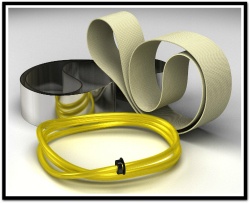A belt is to a skimmer like wheels to a car’s chassi s: although the latter is the most identifiable part, it needs the former to actually run. Just like tires, belts are not one size fits all. Just as there are snow tires, street tires, year-round tires, and more, so too are there a variety of belt materials. So what purpose does each serve?
s: although the latter is the most identifiable part, it needs the former to actually run. Just like tires, belts are not one size fits all. Just as there are snow tires, street tires, year-round tires, and more, so too are there a variety of belt materials. So what purpose does each serve?
Steel belts are the standard for many applications. Their durability, corrosion resistance, and strong oleophilic tendencies make the material effective in most scenarios. The lower price and ease of welding also reduce costs. The biggest caveat is their ineffectiveness when confronted with rust inhibitors in wash water. Steel belts are also ineffective in most applications where PetroXtractors are used.
Elastomer belts are an alternative to steel belts that perform well in a multitude of situations. These belts can handle some of the harshest, most abrasive conditions a skimmer can be placed in and are fully compatible with the PetroXtractor. Still, steel belts will not stretch when exposed to UV rays over a long period of time.
Polymer belts, commonly shortened to poly belts, are meant for higher temperatures and conditions where UV exposure and rust inhibitors are an issue. The textured nature of the poly belts causes more oil than usual to be picked up. This option tends to be pricier, but works like a charm in intense functions.
LFO belts, commonly referred to as Fuzzy belts, are a proprietary skimmer belt exclusive to Abanaki. This material specializes in the rapid removal of light, non-viscous hydrocarbons from water. If your problem is an oil like gasoline, the Fuzzy belt will remove it much more efficiently than any other belt in normal conditions. The Fuzzy belts are also extremely resistant to stretching. Unfortunately, Fuzzy belts are unavailable for the Mighty Mini oil skimmer and do not fare well in extremely hot applications.
XP polymer belts, commonly shortened to XP poly belts, are very similar to poly belts. The key difference comes in its texture and temperature resistance. The XP poly belt is better able to handle high temperatures, maxing out at 180ºF. The belt also has a smooth texture rather than the ridged design of the standard poly belt. Although this change means the XP poly belt will not pick up oil as quickly, the belt will function better than the standard poly belt in conditions that would wear away the ridged design.
Ultimately, your choice of belt is up to you. More information can be found in the Oil Skimmer Factbook or the Belt Selection Guidebook.
If you have any questions, give us a call at (440) 543-7400, e-mail us at skimmers@abanaki.com, or ask us in the chat. Abanaki wants you to find the belt that fits your needs and is more than willing to help.





